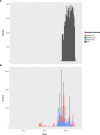The FORCIS database: A global census of planktonic Foraminifera from ocean waters
- PMID: 37270659
- PMCID: PMC10239448
- DOI: 10.1038/s41597-023-02264-2
The FORCIS database: A global census of planktonic Foraminifera from ocean waters
Abstract
Planktonic Foraminifera are unique paleo-environmental indicators through their excellent fossil record in ocean sediments. Their distribution and diversity are affected by different environmental factors including anthropogenically forced ocean and climate change. Until now, historical changes in their distribution have not been fully assessed at the global scale. Here we present the FORCIS (Foraminifera Response to Climatic Stress) database on foraminiferal species diversity and distribution in the global ocean from 1910 until 2018 including published and unpublished data. The FORCIS database includes data collected using plankton tows, continuous plankton recorder, sediment traps and plankton pump, and contains ~22,000, ~157,000, ~9,000, ~400 subsamples, respectively (one single plankton aliquot collected within a depth range, time interval, size fraction range, at a single location) from each category. Our database provides a perspective of the distribution patterns of planktonic Foraminifera in the global ocean on large spatial (regional to basin scale, and at the vertical scale), and temporal (seasonal to interdecadal) scales over the past century.
© 2023. The Author(s).
Conflict of interest statement
The authors declare no competing interests.
Figures





References
-
- Bradshaw, J. S. Ecology of living planktonic foraminifera in the North and Equatorial Pacific Ocean. (University of California, Los Angeles, 1957).
-
- Bé, A. W. & Tolderlund, D. S. Distribution and ecology of living planktonic foraminifera in surface waters of the Atlantic and Indian Oceans. The Micropaleontology of the Oceans (Cambridge University Press, 1971).
-
- Bé, A. An ecological, zoogeographic and taxonomic review of recent planktonic foraminifera. in Oceanic micropalaeontology, Vol.1. Edited by A.T.S. Ramsay. Publisher: London, Academic Press. United Kingdom. P.1-100 p.76-88 (1977).
-
- Hemleben, C., Spindler, M. & Anderson, O. Modern planktonic Foraminifera. Springer-Verlag, Berlin, 363 pp. (Springer-Verlag, 1989). - PubMed
-
- Schiebel R, Hemleben C. Planktic foraminifers in the modern ocean. Springer. 2017 doi: 10.1007/978-3-662-50297-6. - DOI
Publication types
MeSH terms
LinkOut - more resources
Full Text Sources
Miscellaneous

